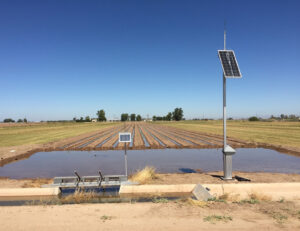Over the last decade, researchers from the University of California (UC) Division of Agriculture and Natural Resources (ANR) and UC Davis have been working at the UC Desert Research and Extension Center (DREC), located in Holtville, California, and carrying out studies on the possibilities offered by automating surface irrigation using gates and software produced by Rubicon. Studies of sugar beets irrigated in the Imperial Valley using furrow irrigation have demonstrated that automation can increase water use efficiency from 70– 75 percent to 85 percent. Moreover, automation reduces labor costs, which make up an increasing percentage of the overall costs of farming. In this interview, we speak to two experts who were involved with the DREC study: Dr. Khaled Bali, a statewide irrigation water management specialist who works for the UC Cooperative Extension (UCCE), and Dr. Stephen Kaffka, an extension specialist and agronomist at UC Davis.
Irrigation Leader: Please tell us about your backgrounds and how you came to be in your current positions.
Khaled Bali: I’m a statewide irrigation water management specialist. I work for the UCCE, which falls under the ANR. Today, I am based at UC’s Kearney Agricultural Research and Extension Center, located in Fresno County in Central California. I do statewide work on issues related to irrigation, water conservation, and climate-smart agriculture. I’ve been with the university for nearly 30 years. During the first 25, I focused on low desert research at the DREC in Holtville, California, near the Mexican border. That’s where we did the work on sugar beets.
Stephen Kaffka: I’m an extension specialist and an agronomist in the Department of Plant Sciences at UC Davis. I’ve been at UC Davis for almost 30 years. I have statewide commodity assignments for sugar and oilseed crops, but I’ve also worked quite a bit on other irrigation-and water-quality-related topics, including water quality and irrigation in the Upper Klamath basin and salinity and drainage issues in the western San Joaquin Valley and, to some degree, in the Imperial Valley. I have been working with Khaled over the last few years on various projects. Water use and related economic issues are important to the sugar beet producers in the Imperial Valley. I cooperated on a successful precision agriculture project in the Imperial Valley with Khaled several years ago that focused on the effects of salinity on yield and fertilizer use efficiency. This research on irrigation is consistent with my responsibilities and overlaps nicely with Khaled’s skills and abilities.
Irrigation Leader: Please tell us about the research on automating surface irrigation that you carried out at the DREC.
Khaled Bali: All the water used for irrigation in the Imperial Valley comes from the Colorado River. As you know, both the upper and lower basins of the Colorado River are facing severe shortages when it comes to the water that goes into the seven states and Mexico. The Imperial Valley grows lots of field crops, 70–80 percent of which are field crops like alfalfa, wheat, sugar beets, Sudan grass, Bermuda grass, and other types of grasses. Sugar beets are one of the major crops in the Imperial Valley, and the Imperial Valley is the only major production area for sugar beets in California. Typically, there are about 25,000 acres of sugar beets there per year. Sugar beets are typically planted around September and harvested between April and July. All the sugar beets in the Imperial Valley are irrigated with flood irrigation, also known as surface irrigation. One type of surface irrigation is furrow irrigation, which involves growing sugar beets between furrows about 30 inches wide.
Using surface irrigation, you have to apply enough water to meet the crop water demand. The process of applying that order is not 100 percent efficient, especially with furrow irrigation. If you apply enough water to get enough moisture into the soil profile, you end up with water leaving the field at the end of the irrigation event, which is known as runoff. Any water that leaves the field is lost water. There is significant surface runoff with the type of soils that we have in Imperial Valley, which are on the heavy side. Generally, furrow irrigation causes more runoff than other surface irrigation systems, such as border irrigation. Our objective here is to automate surface irrigation systems to minimize runoff so that we can increase irrigation efficiency and reduce surface runoff.

Stephen Kaffka: Many of these fields are quite large, and it’s hard to apply water uniformly and efficiently on them. These automated surface irrigation technologies have the potential to reduce overirrigation at the head end of the field and underirrigation and runoff at the tail end of the field, which improves water use efficiency.
Irrigation Leader: Would this research be applicable to any furrow-irrigated crop or just to sugar beets?
Khaled Bali: It would be applicable to any surface irrigation system, including furrow, basin, or border irrigation.
Stephen Kaffka: This is the first trial with row crops that we know of in Imperial Valley. The previous work dealt largely with alfalfa, which uses a flood or border irrigation system without rows or beds. The Australians have used this technology successfully with cotton on beds in large irrigated fields. We wanted to get some experience with sugar beets. As Khaled said, the Imperial Valley has relatively secure water rights, but there is concern about water rights in the Colorado River basin, so it is prudent to pursue research on how to become more efficient. Savings of even 10–15 percent are significant.
Irrigation Leader: What technology were you testing?
Khaled Bali: We were using gates and software made by Rubicon, which has extensive experience in this type of work, as Steve mentioned. It is the leader in terms of farm automation. It has reliable software and various irrigation system components. The gate we have at the DREC has been there for 9 years, and we have had very few issues with maintenance. It is a good and reliable system that has been working well in the harsh desert environment.
Irrigation Leader: Tell us about the study and its results.
Khaled Bali: We have been doing automation for at least 7–8 years. We started at the DREC and then expanded to an automatic system with an alfalfa grower in the Imperial Valley. We have lots of data documenting how much water and labor we can save. It’s not just about the water savings— labor costs have been going up and are a major component of the total costs of producing sugar beets or any other field crop in California.
As Steve mentioned, Rubicon has done lots of work in Australia. Universities and researchers in Australia have looked at automating furrow irrigation for cotton. With a traditional furrow irrigation system, an irrigator goes to the field and turns on the water for a section of the field and judges how long to keep it on based on their experience and how much flow is coming in. They might keep it running for 4, 5, or 6 hours in one section before opening another. The work is 100 percent manual, and the decisions are made based on the experience of the irrigators.
Instead of having an irrigator opening and closing the gates, we have the system open the gates automatically. As the water advances and moves through the field, we measure the flow rate and how fast the water is moving. With this information and other site-specific information, such as soil type and field slope, we can make real-time decisions about irrigation runtime. It provides much more control over flow rate than manual operation. It’s kind of like cruise control on a car—it keeps the flow steady, but you have the ability to slow down if you need to. It gives you a lot of flexibility.
Stephen Kaffka: The labor cost issue is very much in the minds of farmers. California has passed a number of new laws and regulations in recent years that increase the costs of agricultural labor, including laws related to overtime, health benefits, and so on. Field crops in particular have low margins of profitability, and increased labor costs could eat up all the profit. Automating surface irrigation is an important technological improvement for keeping the sugar beet crop economic, and it could be used for other crops, too.
Irrigation Leader: How has the labor cost issue been developing?
Khaled Bali: As California implements increases in minimum wage standards, labor savings have moved to the forefront of concerns. Right now, the minimum wage is $14 an hour for large companies. By January 2022, it will be $15 plus about 40 percent of overhead. To sustain field crops in California, we have to find ways to reduce the cost of irrigation labor. That’s a big component of this work.
Stephen Kaffka: It’s going to affect all kinds of things, including picking peaches. It’s an interesting problem. It’s not that you want to put people out of work, it’s just that the policy choices that are being made and the economic realities of farming favor automation if farms are to stay in business. Automation gives farmers more and better control of resource use. It supports more-efficient management by the farmer. The fewer variables associated with getting the water on and having labor show up and so on, the better. Farmers can manage automated systems from their cell phones, which is appealing. It’s consistent with the modernization pathways that agriculture has followed for decades.
Irrigation Leader: What results did your study find?
Khaled Bali: A typical furrow irrigation system for sugar beets or similar crops can achieve 70–75 percent efficiency. The minute we go to automation, we can achieve about 85 percent efficiency. That goes a long way when you’re looking at a desert region like Southern California, where evapotranspiration rates are relatively high during the spring and summer months, and it is still hot even in September and October.
Irrigation Leader: Is the DREC working to diffuse these results to sugar beet farmers?
Stephen Kaffka: We have annual workgroup meetings for sugar beet growers and other people in the sugar beet industry at the DREC, and we reported these results over a 2‑year period at those meetings and elsewhere. There are a number of farmers who have become interested. Baja Farms is now in the process of cooperating with Khaled and me on a grant proposal to submit to Imperial County to support the installation of this on-farm technology on a couple of fields that it uses for alfalfa, sugar beets, wheat, and other crops. The farm is owned by a long-term pioneer family in the valley that holds the current world record for sugar beet yields. If we’re successful in automating the family’s fields and it has results that it likes, the results will spread through the valley, since there’s a community of growers there that all know each other. I have found that if a technology works, makes sense, and is economic, it’s a relatively easy sell. Those things propagate pretty readily.
Irrigation Leader: In general, how do the DREC and other extension centers find out about technological solutions that have the potential to benefit local farmers? Do technology companies usually reach out to you, or do you actively look for things that are worth testing?
Khaled Bali: In general, technology companies approach us. We conduct educational activities, such as workshops and field days. The irrigation industry knows about the UCCE, and it knows that we’re well connected with the agricultural industry in California. Most of our research projects are done with the growers. We operate nine research centers all over the state directly with the growers, and there is a UCCE presence in every county in California.
Irrigation Leader: What are the next steps in this particular research project?
Khaled Bali: The next step is to implement automation on a large commercial field in the Imperial Valley with a sugar beet grower. The field we have selected is about 70 acres in size.
Irrigation Leader: What is your vision for the future of desert agriculture and surface irrigation?
Stephen Kaffka: The Imperial Valley is one of the most productive places anywhere in the world. It has the highest sugar beet yields in the world by quite a bit. The high-quality durum wheat produced here is in high demand internationally, and the Imperial Valley is also an important producer of alfalfa, which has an international market. The difficulties are that it is a desert environment with a high demand for water. I think that if this irrigation technology works well in the Imperial Valley, it can serve as a model for irrigated agriculture in other hot desert and semiarid climates. This technology integrates all kinds of new digital capacities. Information on infiltration rates on a field scale become part of your data. You can use Internet technology to control the system. If you already have a highly efficient system and can save 10–20 percent of the water that you used previously, you can keep your operations viable and maintain or increase yields while lowering your water use and your greenhouse gas emissions.
Khaled Bali: We’re facing serious challenges when it comes to climate change and water supplies. We have to look at ways to increase efficiency and sustain agriculture with more efficient practices.
Khaled Bali is a statewide irrigation water management specialist based at the University of California’s Kearney Agricultural Research and Extension Center. He can be contacted at kmbali@ucanr.edu or (559) 646‑6541.

Stephen Kaffka is an extension specialist and an agronomist at the University of California, Davis. He can be contacted at srkaffka@ucdavis.edu.

